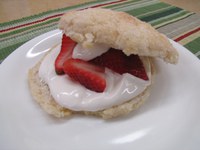Prairie Fare: Exercise and Nourish Your Joints This Summer
(Click an image below to view a high-resolution image that can be downloaded)
By Julie Garden-Robinson, Food and Nutrition Specialist
NDSU Extension Service
A scene from the famous “The Wizard of Oz” movie came to mind the other morning. I wasn’t recalling the yellow brick road or flying monkeys. As I arose for the day, I thought about the first meeting Dorothy and the Scarecrow had with the Tin Man.
Unfortunately, in this reminiscence, I was not Dorothy skipping along happily. I was the Tin Man.
Unlike the Tin Man, I have a heart and it’s OK. My muscles and joints were feeling kind of rusty, though.
You might recall that the Tin Man needed his joints oiled so he could walk, move his arms and talk. I was the Tin Man, barely able to move after I rolled out of bed.
I did not need to have my mouth oiled like the Tin Man, though. I could complain.
I had spent many hours gardening the previous day. I awakened some neglected muscles, and they were not happy after several hours of raking, shoveling and hauling heavy planters filled with soil around our backyard.
My husband and son, who hauled a mountain of soil from the front yard to the backyard, had awakened their muscles, too. On the positive side, we burned quite a few calories and our yard is looking better.
According to a calorie expenditure website, an adult who weighs 150 pounds burns about 272 calories per hour doing general gardening work. Shoveling at a moderate rate (10 to 15 pounds per minute) burns about 476 calories per hour.
Fortunately, after walking around a little that morning, my joints stopped creaking. Next time, I will warm my muscles and joints by starting a little more slowly.
Unfortunately, many people face chronic pain and stiffness due to joint issues. Although I don’t have arthritis, I know a lot of people who do.
According to the Centers for Disease Control and Prevention (CDC), about 50 million people in the U.S. have been told by their health-care provider they have some form of arthritis or other chronic joint health issues.
The annual price tag related to arthritis was $128 billion in 2003, and osteoarthritis is a leading cause of disability. If you are among the many people who suffer from arthritis or other joint issues, consider some of the lifestyle-related approaches, along with medications you might be taking.
Low-impact exercise can help with the management of arthritis because it promotes weight management and flexibility. Discuss your physical activity plans with a health-care provider.
Swimming and water aerobics, for example, put less pressure on joints and can help decrease swelling and increase circulation to joints and muscles. Of course, if something causes joint pain, stop the activity right away.
Nutrition has been explored by researchers as a means of reducing the inflammation associated with arthritis. Omega-3 fatty acids in oils and fish may decrease the inflammation associated with arthritis. According to the latest nutrition guide, we should eat 8 ounces of seafood, such as salmon, per week.
Chronic pain can affect our appetite, so we may not feel like eating. Therefore, we need to aim for “nutrient-rich” foods from all the food groups, including plenty of fruits, vegetables, whole grains, lean protein and low-fat dairy. See http://www.myplate.gov for more information about building a healthful plate.
According to current recommendations, filling our plate half full with fruits and vegetables helps us meet our nutritional needs for vitamins, minerals and assorted phytochemicals (natural, health-promoting plant chemicals) that promote good health. Fruits and vegetables also are high in water and low in calories.
Drink plenty of water to keep your body well hydrated. We may be dehydrated without feeling thirsty, so carry a water bottle and sip regularly. If you do not like water, add ice and a squirt of lemon or lime juice. Be aware that some beverages are high in calories, so read the nutrition facts labels.
You don’t need to be a “wizard” in the kitchen to make this quick and easy summer dessert. Enjoy some seasonal fruit such as strawberries or raspberries. Pair it with an ice-cold glass of milk or lemonade. For more information about food and fitness, visit http://www.ndsu.edu/eatsmart.
Easy Strawberry Shortcake
1 (10-ounce) can refrigerated reduced-fat buttermilk biscuits (eight biscuits)
1/4 c. low-fat milk
1/4 c. sugar
12 ounces of vanilla yogurt
2 c. (1 1/2 pints) fresh strawberries, sliced (or peaches, blueberries or raspberries)
Heat the oven to 375 degrees F. Separate the dough into eight biscuits. Dip tops and sides of each biscuit in milk and then dip in sugar. Place on ungreased cookie sheet. Bake 13 to 17 minutes or until golden brown. Cool for five minutes. Slice the biscuits in half, fill with yogurt and sliced strawberries and top with the other half of the biscuit and serve.
Makes eight servings. Each serving has 170 calories, 4.5 grams (g) of fat, 5 g of protein, 28 g of carbohydrate, 1 g of fiber and 390 milligrams of sodium.
(Julie Garden-Robinson, Ph.D., R.D., L.R.D., is a North Dakota State University Extension Service food and nutrition specialist and associate professor in the Department of Health, Nutrition and Exercise Sciences.)
NDSU Agriculture Communication – May 24, 2012
| Source: | Julie Garden-Robinson, (701) 231-7187, julie.garden-robinson@ndsu.edu |
|---|---|
| Editor: | Rich Mattern, (701) 231-6136, richard.mattern@ndsu.edu |




